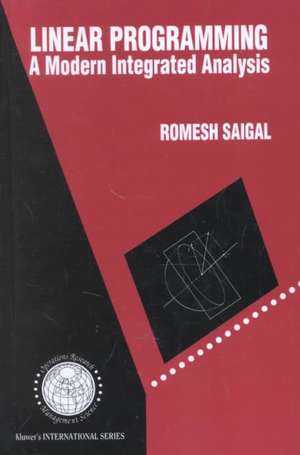Linear Programming: A Modern Integrated Analysis: International Series in Operations Research & Management Science, cartea 1
Autor Romesh Saigalen Limba Engleză Hardback – 30 noi 1995
A new and inductive proof of Kantorovich's Theorem is offered, related to the convergence of Newton's method. Of the boundary methods, the book presents the (revised) primal and the dual simplex methods. An extensive discussion is given of the primal, dual and primal-dual affine scaling methods. In addition, the proof of the convergence under degeneracy, a bounded variable variant, and a super-linearly convergent variant of the primal affine scaling method are covered in one chapter. Polynomial barrier or path-following homotopy methods, and the projective transformation method are also covered in the interior point chapter. Besides the popular sparse Cholesky factorization and the conjugate gradient method, new methods are presented in a separate chapter on implementation. These methods use LQ factorization and iterative techniques.
| Toate formatele și edițiile | Preț | Express |
|---|---|---|
| Paperback (1) | 1383.14 lei 6-8 săpt. | |
| Springer Us – 27 sep 2012 | 1383.14 lei 6-8 săpt. | |
| Hardback (1) | 1225.94 lei 6-8 săpt. | |
| Springer Us – 30 noi 1995 | 1225.94 lei 6-8 săpt. |
Din seria International Series in Operations Research & Management Science
- 20%
 Preț: 331.25 lei
Preț: 331.25 lei - 20%
 Preț: 570.61 lei
Preț: 570.61 lei - 18%
 Preț: 1132.02 lei
Preț: 1132.02 lei - 18%
 Preț: 773.72 lei
Preț: 773.72 lei -
 Preț: 170.39 lei
Preț: 170.39 lei - 17%
 Preț: 459.34 lei
Preț: 459.34 lei - 17%
 Preț: 360.47 lei
Preț: 360.47 lei -
 Preț: 263.40 lei
Preț: 263.40 lei - 24%
 Preț: 905.30 lei
Preț: 905.30 lei - 17%
 Preț: 460.08 lei
Preț: 460.08 lei - 17%
 Preț: 459.34 lei
Preț: 459.34 lei - 20%
 Preț: 631.58 lei
Preț: 631.58 lei - 13%
 Preț: 448.62 lei
Preț: 448.62 lei - 18%
 Preț: 738.28 lei
Preț: 738.28 lei - 18%
 Preț: 948.92 lei
Preț: 948.92 lei - 18%
 Preț: 703.88 lei
Preț: 703.88 lei - 18%
 Preț: 957.44 lei
Preț: 957.44 lei - 15%
 Preț: 651.84 lei
Preț: 651.84 lei - 20%
 Preț: 336.21 lei
Preț: 336.21 lei - 15%
 Preț: 641.03 lei
Preț: 641.03 lei -
 Preț: 404.29 lei
Preț: 404.29 lei - 18%
 Preț: 950.21 lei
Preț: 950.21 lei - 15%
 Preț: 649.06 lei
Preț: 649.06 lei - 18%
 Preț: 725.75 lei
Preț: 725.75 lei -
 Preț: 394.12 lei
Preț: 394.12 lei - 18%
 Preț: 951.47 lei
Preț: 951.47 lei - 15%
 Preț: 639.59 lei
Preț: 639.59 lei - 18%
 Preț: 773.06 lei
Preț: 773.06 lei - 18%
 Preț: 889.29 lei
Preț: 889.29 lei - 15%
 Preț: 655.60 lei
Preț: 655.60 lei - 15%
 Preț: 640.06 lei
Preț: 640.06 lei - 15%
 Preț: 583.93 lei
Preț: 583.93 lei
Preț: 1225.94 lei
Preț vechi: 1495.04 lei
-18% Nou
Puncte Express: 1839
Preț estimativ în valută:
234.61€ • 240.26$ • 195.16£
234.61€ • 240.26$ • 195.16£
Carte tipărită la comandă
Livrare economică 18 martie-01 aprilie
Preluare comenzi: 021 569.72.76
Specificații
ISBN-13: 9780792396222
ISBN-10: 0792396227
Pagini: 342
Ilustrații: XIII, 342 p.
Dimensiuni: 155 x 235 x 21 mm
Greutate: 0.68 kg
Ediția:1995
Editura: Springer Us
Colecția Springer
Seria International Series in Operations Research & Management Science
Locul publicării:New York, NY, United States
ISBN-10: 0792396227
Pagini: 342
Ilustrații: XIII, 342 p.
Dimensiuni: 155 x 235 x 21 mm
Greutate: 0.68 kg
Ediția:1995
Editura: Springer Us
Colecția Springer
Seria International Series in Operations Research & Management Science
Locul publicării:New York, NY, United States
Public țintă
ResearchCuprins
1 Introduction.- 1.1 The Problem.- 1.2 Prototype Problems.- 1.3 About this Book.- 1.4 Notes.- 2 Background.- 2.1 Real Analysis.- 2.2 Linear Algebra and Matrix Analysis.- 2.3 Numerical Linear Algebra.- 2.4 Convexity and Separation Theorems.- 2.5 Linear Equations and Inequalities.- 2.6 Convex Polyhedral Sets.- 2.7 Nonlinear System of Equations.- 2.8 Notes.- 3 Duality Theory and Optimality Conditions.- 3.1 The Dual Problem.- 3.2 Duality Theorems.- 3.3 Optimality and Complementary Slackness.- 3.4 Complementary Pair of Variables.- 3.5 Degeneracy and Uniqueness.- 3.6 Notes.- 4 Boundary Methods.- 4.1 Introduction.- 4.2 Primal Simplex Method.- 4.3 Bounded Variable Simplex Method.- 4.4 Dual Simplex Method.- 4.5 Primal — Dual Method.- 4.6 Notes.- 5 Interior Point Methods.- 5.1 Primal Affine Scaling Method.- 5.2 Degeneracy Resolution by Step-Size Control.- 5.3 Accelerated Affine Scaling Method.- 5.4 Primal Power Affine Scaling Method.- 5.5 Obtaining an Initial Interior Point.- 5.6 Bounded Variable Affine Scaling Method.- 5.7 Affine Scaling and Unrestricted Variables.- 5.8 Dual Affine Scaling Method.- 5.9 Primal-Dual Affine Scaling Method.- 5.10 Path Following or Homotopy Methods.- 5.11 Projective Transformation Method.- 5.12 Method and Unrestricted Variables.- 5.13 Notes.- 6 Implementation.- 6.1 Implementation of Boundary Methods.- 6.2 Implementation of Interior Point Methods.- 6.3 Notes.- A Tables.
Recenzii
`I recommend this book to anyone desiring a deep understanding of the simplex method, interior-point methods, and the connections between them.'
Interfaces, 27:2 (1997)
The book is clearly written. ... It is highly recommended to anybody wishing to get a clear insight in the field and in the role that duality plays not only from a theoretical point of view but also in connection with algorithms.'
Optimization, 40 (1997)
Interfaces, 27:2 (1997)
The book is clearly written. ... It is highly recommended to anybody wishing to get a clear insight in the field and in the role that duality plays not only from a theoretical point of view but also in connection with algorithms.'
Optimization, 40 (1997)














